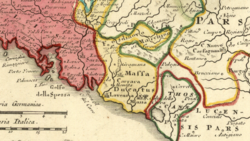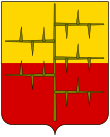
The Lunigiana or Lunesana is a historical territory of Italy, which today falls within the provinces of Massa Carrara, Tuscany, and La Spezia, Liguria. Its borders derive from the ancient Roman settlement, later the medieval diocese of Luni, which no longer exists.

Saluzzo is a town and former principality in the province of Cuneo, in the Piedmont region, Italy.
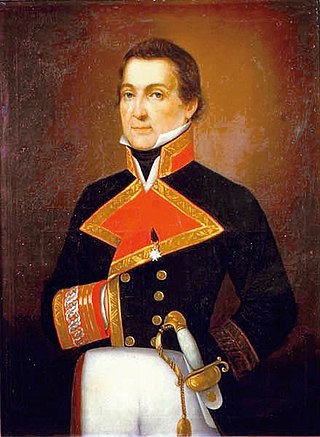
Alejandro Malaspina was a Tuscan explorer who spent most of his life as a Spanish naval officer. Under a Spanish royal commission, he undertook a voyage around the world from 1786 to 1788, then, from 1789 to 1794, a scientific expedition throughout the Pacific Ocean, exploring and mapping much of the west coast of the Americas from Cape Horn to the Gulf of Alaska, crossing to Guam and the Philippines, and stopping in New Zealand, Australia, and Tonga.

Porto Venere is a town and comune (municipality) located on the Ligurian coast of Italy in the province of La Spezia. It comprises the three villages of Fezzano, Le Grazie and Porto Venere, and the three islands of Palmaria, Tino and Tinetto. In 1997 Porto Venere and the villages of Cinque Terre were designated by UNESCO as a World Heritage Site.

Bernabò or Barnabò Visconti was an Italian soldier and statesman who was Lord of Milan. Along with his brothers Matteo and Galeazzo II, he inherited the lordship of Milan from his uncle Giovanni. Later in 1355, he and Galeazzo II were rumoured to have murdered their brother Matteo since he endangered the regime. When Galeazzo II died, he shared Milan's lordship with his nephew Gian Galeazzo. Bernabò was a ruthless despot toward his subjects and did not hesitate to face emperors and popes, including Pope Urban V. The conflict with the Church caused him several excommunications. On 6 May 1385, his nephew Gian Galeazzo deposed him. Imprisoned in his castle, Trezzo sull'Adda, he died a few months later, presumably from poisoning.

The Duchy of Massa and Principality of Carrara was a small state that controlled the towns of Massa and Carrara from 1473 until 1836.
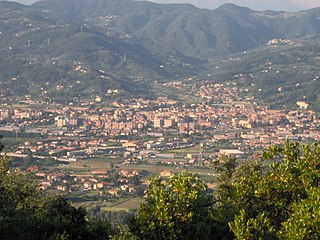
Sarzana is a town, comune (municipality) and former short-lived Catholic bishopric in the Province of La Spezia, Liguria, Italy. It is 15 kilometres (9 mi) east of La Spezia, on the railway to Pisa, at the point where the railway to Parma diverges to the north. In 2010, it had a population of 21,978.

Pontremoli is a small city, comune former Latin Catholic bishopric in the province of Massa and Carrara, Tuscany region, central Italy.

The Marquisate of Saluzzo was a historical Italian state that included parts of the current region of Piedmont and of the French Alps. The Marquisate was much older than the Renaissance lordships, being a legacy of the feudalism of the High Middle Ages.
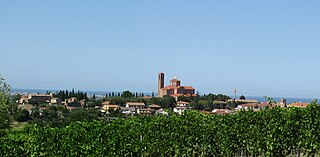
Coriano is a comune in the province of Rimini. This town is known for being the town of the Motorcycle World Champion, in 250cc class, Marco Simoncelli.

Moneglia is a comune (municipality) in the Metropolitan City of Genoa in the Italian region Liguria, located about 50 kilometres southeast of Genoa. It is a tourist resort on the Riviera di Levante. It is one of I Borghi più belli d'Italia.

Robbiate is a comune (municipality) in the Province of Lecco in the Italian region Lombardy, located about 30 kilometres (19 mi) northeast of Milan and about 20 kilometres (12 mi) south of Lecco. As of 31 December 2004, it had a population of 5,333 and an area of 4.7 square kilometres (1.8 sq mi).
RidolfoII da Varano, signore di Camerino, was a condottiero operating in Italy from the 1360s. His forebears had long held the rocca of Varano on the borderland of the Papal States, controlling a major strategic pass between Umbria and the Marche, a link between Rome and the Adriatic coast. He inherited from Gentile di Berardo da Varano in 1355, and undertook the improvement of the fortifications that protected the commune and its rocca.
Spinetta Malaspina (1282–1352), also known as Spinetta Malaspina the Great, a descendant of Obizzo Malaspina, was the Marquisse of Verrucola and the lord of Fosdinovo. He is the forefather of the marquisses of Fosdinovo and of its related imperial feud.

Giano I di Campofregoso was the 31st Doge of the Republic of Genoa.

The House of Malaspina was a noble Italian family of Longobard origin that descended from Boniface I, through the Obertenghi line, that ruled Lunigiana from the 13th to the 14th centuries, and the marquisate of Massa and lordship of Carrara since the 14th century.
Galeotto Malaspina was an Italian judge and nobleman. He was the son of Azzolino II Malaspina and grandson of Spinetta Malaspina, he is remembered to be the first Marquis of Fosdinovo.

Gabriele Malaspina was an Italian nobleman. He was the son of Galeotto I Malaspina, he is remembered as the second marquis of Fosdinovo.
Spinetta Malaspina II, Duke of Gravina in Apulia was an Italian nobleman. Son of Galeotto I Malaspina, he was the third Marquis of Fosdinovo.
